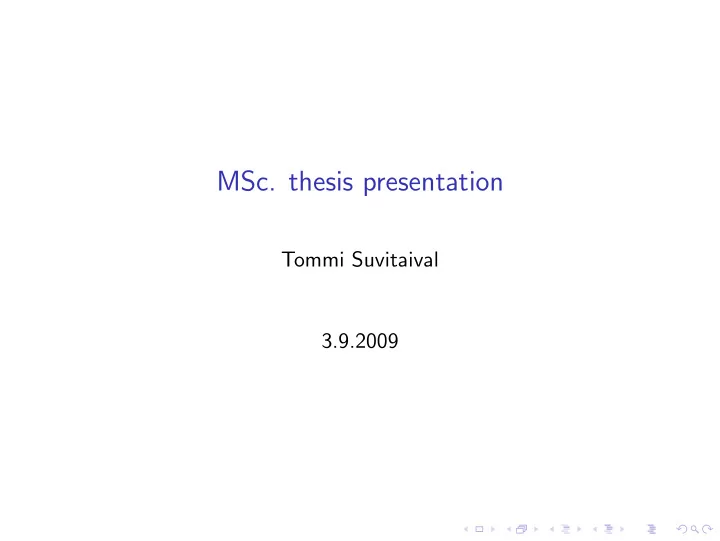

MSc. thesis presentation Tommi Suvitaival 3.9.2009
◮ Title: Bayesian Two-Way Analysis of High-Dimensional Collinear Metabolomics Data ◮ Instructor: MSc. Ilkka Huopaniemi ◮ Supervisor: Prof. Samuel Kaski
Contents ◮ Introduction to analysis of high-throughput biological data ◮ The focus is in metabolomics and multi-way analysis ◮ A new method is proposed and applied to biological data
Bioinformatics ◮ Bioinformatics analyses observations from biological organisms ◮ Analysis is performed using computational and statistical methods ◮ Lines of bioinformatics study genome, gene activity, protein concentration and metabolite concentration. ◮ Aim at gaining new knowledge on functioning of the biological system ◮ Often motivated by an interest in finding an explanation to a disease
Metabolomics ◮ A line of bioinformatics studying concentrations of small molecules, metabolites ◮ Metabolite is a substrate or product of a biological process that is catalysed by proteins ◮ Lipids are a sub-group of metabolites ◮ Lipids take part in many important biological processes, such as cell signaling ◮ Changes in lipid concentrations are related to many metabolic diseases, such as diabetes
Experiment setup in bioinformatics ◮ High-throughput measurements produce observations from large numbers of features ◮ n < p problem: less samples than features in the data ◮ Number of samples is low due to high financial and ethical costs ◮ In metabolomic data, one feature corresponds to concentration of one metabolite ◮ One sample is a vector of features measured from one patient on one occasion
A metabolomic data set (1) Figure: An example data matrix, where patients have two treatments.
A metabolomic data set (2) Figure: Simulated data. Can you identify treatment effects?
Traditional solutions ◮ ANOVA (analysis of variance): univariate method handling one feature at a time ◮ MANOVA (multivariate analysis of variance): multivariate but non-functioning for n < p data
Bayesian method: justification ◮ To deal with the n < p problem ◮ To estimate uncertainty of the model ◮ To bring prior knowledge into the model
Bayesian method: clustering and multi-way analysis ◮ Features are clustered according to similarity ◮ Common treatment effects for each cluster are estimated
Bayesian method vs. a traditional approach dimensionality multi-way > > > > knowledge data normalization reduction analysis Figure: The usual process of high-throughput data analysis ◮ The proposed model includes all three steps ◮ Instead of performing the steps sequentially, they are done simultaneously within the model
Bayesian method: the plate graph Figure: The plate graph
Type 1 diabetes study (1) ◮ Finnish children were screened for type 1 diabetes ◮ The children were monitored 1 to 4 times a year ◮ Certain antibody levels in blood were measured ◮ These antibodies are useful in indicating the onset of the disease ◮ It is already too late to prevent the disease at the time the antibodies emerge
Type 1 diabetes study (2) ◮ Could be detected earlier from the metabolic profile? ◮ Around 100 children took part in a more detailed study, where lipid profiles were measured from blood serum ◮ 53 lipids were identified ◮ Only 54 patients were included in analysis due to missing time points ◮ The Bayesian method was used to find possible predictors of the disease
Results with a lipidomic data set (1) Figure: Estimated treatment effects of a two-way data set
Results with a lipidomic data set (2) Figure: Estimated time and time-disease interaction effect of a time series data set
Results with simulated data Figure: Estimated treatment effects as function of sample-size
Recommend
More recommend